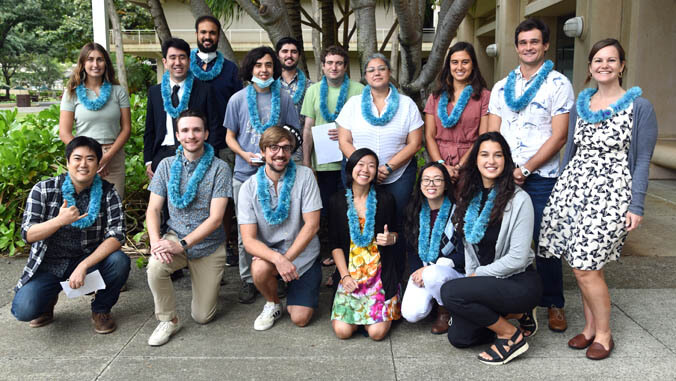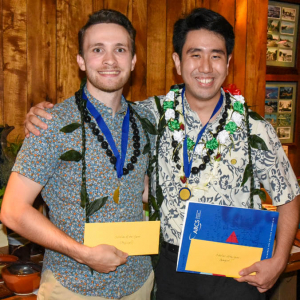
University of Hawaiʻi at Mānoa Institute for Astronomy doctoral candidate Miles Lucas and John A. Burns School of Medicine PhD student Nicholas Kawasaki were named ARCS Foundation Honolulu Chapter’s 2022 Scholars of the Year. Lucas received the Jacquie Maly ARCS Scholar of the Year Award for best presentation in physical sciences at the ARCS Scholar Symposium earlier in the spring. Kawasaki received the Sherry Lundeen ARCS Scholar of the Year Award for best presentation in the biological sciences.

ARCS Honolulu Chapter provided the two $1,000 Scholar of the Year grants in addition to $5,000 awarded to each of the 20 UH Mānoa PhD candidates named ARCS Scholars in 2022.
The non-profit volunteer group works to advance science in America by providing unrestricted funding to outstanding U.S. graduate students in STEM fields. The Honolulu chapter has provided more than $2.7 million to UH for more than 650 graduate students since 1974.
The 2022 awards were made within six UH Mānoa units. For more information about each scholar, including links to videos in which they describe their research, go to the ARCS website.
The 2022 Honolulu ARCS Scholars
Institute for Astronomy
Jason Hinkle received the Columbia Communications Award. He looks for trends in data from different spectra to study supermassive black holes that lie at the center of most massive galaxies, including the Milky Way. The goal is a better understanding of how galaxies evolve.
Miles Lucas received the George and Mona Elmore ARCS Award. He works to design instruments, observational techniques and processing methods for directly imaging exoplanets and planet-forming regions. He hopes new ways of “seeing” largely invisible gasses will help explain planet formation.
John A. Burns School of Medicine
Aneesa Golshan received the Kai Bowden ARCS Award. Golshan wants to improve vaccine delivery systems and adjuvants that trigger and ramp up immune response. She studies the optimal size of iron oxide nanoparticles, which are a safe, inexpensive, stable and highly reproducible contender.
Nicholas Kawasaki received the Guy Moulton Yates ARCS Award. He uses mouse models to study ferroptosis, an iron-dependent form of cell death that occurs in the heart after blood flow is restored following a heart attack. Intervention by an inhibitor might reduce cell death after a heart attack. Kawasaki is co-author of a book chapter on the topic with 2011 ARCS Scholar Jason Higa, now an assistant professor at JABSOM.
Katie Lee received the George and Mona Elmore Award. Lee also uses mice to examine what happens in the heart after an attack. She is examining the role of PKM genes in regulating the heart’s use of glucose for energy following cardiac events in the hopes of ensuring better outcomes.
College of Engineering
Ahmed Afifi received the Bretzlaff Foundation ARCS Award. Afifi quantifies “virtual water,” the volume consumed to produce commercial products, such as food crops. He envisions international trade in virtual water as a way to develop management strategies that could conserve water and mitigate political conflicts.
Rintaro Hayashi received the Frederick M. Kresser ARCS Award. He takes inspiration from tiny ubiquitous marine crustaceans called copepods, which use appendages to swim, pump and sense, to design equally tiny robots that can operate in a fluid environment.
College of Natural Sciences
Richard (Trey) Carney III received the Sarah Ann Martin ARCS Award. He worked on systems for unmanned aerial vehicles and quadcopters, but his recent research applies mathematical modeling to the COVID-19 epidemic. He seeks to balance cumbersome compartmentalized models, which track individuals, with network aggregation systems to better track and predict spread of the disease.
Ana Flores received the Maybelle F. Roth ARCS Award. Flores has grown Hawaiʻi’s native poppy, pua kala, under controlled conditions to study how plants respond to environmental stresses, such as heat and drought, at various stages of development. Field experiments are next.
Kazuumi Fujioka received the Sarah Ann Martin ARCS Award. Fujioka uses computational methods to visualize chemical reactions with molecular dynamics, seeking faster, more accurate methods for understanding how atoms interact. With stronger agreement between experimental and calculation approaches, chemists could better describe what’s happening in difficult-to-observe conditions, such as astro-chemistry.
Holden Jones received the Ellen M. Koenig ARCS Award. Jones was introduced to the Amazon rainforests during a summer undergraduate experience. His ARCS award augments a Fulbright research stipend for PhD work in cacao agroforests in Ecuador. He studies amphibians as an indicator species to gauge the impact of monoculture plantations and environmental stressors on ecosystem diversity.
Kevin Keefe received the Honolulu ARCS Award. Keefe explores new ways to detect the tiniest particles in the massive Deep Underground Neutrino Experiment accelerators, using time rather than charge. An invited speaker at professional conferences and former teacher, he describes experimentalists as “people looking to break things.”
Helen Sung received the Ellen M. Koenig ARCS Award. Sung studies the hybridization of fresh- and salt-water crocodiles as habitat loss pushes them into increasingly overlapping territory. She will discuss her findings, hybridization’s impact on adaptation and what that means for conservation strategies at the International Union for Conservation of Nature’s Species Survival Commission—Crocodile Specialist SubGroup meeting in Mexico.
Benjamin Strauss received the Ellen M. Koenig ARCS Award. Strauss works at the intersection of biology and technology. He applies machine learning and neural networks to large datasets on protein structures, seeking to predict protein functions based on different ways they are folded into 3D structures.
School of Ocean and Earth Science and Technology
Marley Chertok received the Toby Lee ARCS Award. Chertok uses remote sensing techniques to look at impact craters on the lunar surface in order to learn what they reveal about hidden ancient interior lava flows. She previously worked on a geologic history of Northwestern Zambia to assist with an environmental impact study related to refugee resettlement.
Terrence J. Corrigan received the George and Marie Elmore ARCS Award. Corrigan is a storm chaser. He will aim Stereo Atmospheric Motion Monitor cameras at the Ko‘olau range to gauge the interplay of wind and topography. His goal is to predict when simple tradewind showers will evolve into severe rotating thunderstorms, such as the 2018 supercell thunderstorm over Kaua‘i that shattered previous 24-hour U.S. rainfall records.
Shannon McClish received the George and Mona Elmore ARCS Award. McClish studies the impact of seasonal changes in Antarctic Sea ice on nutrient and carbon dioxide uptake and release by phytoplankton. Robotic floats let her collect data during periods when ship-based sampling isn’t possible. She hopes to work at the intersection of science research and policy.
Sarah Tucker received the George and Mona Elmore ARCS Award. Tucker has demonstrated an uncanny ability to grow a ubiquitous group of bacteria called SAR11 in the laboratory. Using bacteria grown in the lab and collected in Kāne‘ohe Bay, she unravels the metabolic pathways at work in this important but little understood player in global carbon cycles.
College of Tropical Agriculture and Human Resources
Rina Carrillo received the Helen Jones Farrar ARCS Award. Carrillo is interested in how plants respond to stress. A gene called Pdi9 may play a protective role as heat causes proteins to unfold and fold irregularly. Understanding the process could lead to better strategies for improving plant tolerance to heat as temperatures continue to rise.
Shannon Wilson received the Joseph Parker ARCS Award. She studies the twoline spittlebug, a significant agricultural pest affecting sugarcane and pasture grass. She has collected spittlebug population and host plant data from Hawaiʻi cattle ranches and is testing nine species of grasses to identify the most resistant strains.

